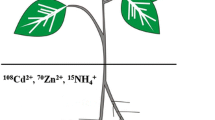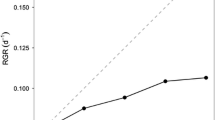Abstract
3H-ABA was introduced into the xylem stream of maize ( Zea mays}) leaves on intact plants by incubation of a semi-attached ‘flap’ of the sheath in solutions. The relative contribution of exportation and metabolism to the fate of xylem-delivered ABA was assessed in leaves which were either kept at different water potentials through soil drying treatments or subjected to different xylem pHs (pH 7.4 vs. pH 5.5) through a phosphate buffer in the feeding solutions. Xylem-delivered ABA was rapidly metabolised in well-watered leaves with a half-life of 2.19 h in the relatively mature leaves used in this study. Re-exportation of xylem-delivered ABA from leaves was much slower than metabolism. It took 24 h for half of the fed radioactivity to disappear from the well-watered leaves, and very possibly this radioactivity was in the form of metabolites of fed 3H-ABA. Although soil drying usually increases the output of ABA through phloem as reported in previous studies, it greatly reduced the re-exportation of xylem-fed ABA and/or its metabolites. Metabolism was also significantly reduced by the treatment of soil drying (half-life extended from 2.19 to 3.63 h), although the magnitude of change was much less than that of exportation. Manipulation of the pH in the feeding solution also had its effect on the re-exportation. A shift of pH from 5.5 to 7.4 reduced the rate of disappearance of the total radioactivity fed into the attached leaves, but showed no significant effect on the rate of ABA metabolism. It was concluded that it was the ABA metabolism, rather than a re-exportation from leaves, which was mainly responsible for the disposal of the ABA signal from the xylem and therefore preventing an accumulation in leaves. Water stress and pH increase of xylem sap would increase the time of such ABA's presence in the leaves. Since xylem-imported ABA is unlikely to be re-exported from leaves in its intact form, we believe a recycling of ABA from xylem to phloem through leaves plays only a minor role.
Similar content being viewed by others
References
Behl R and Hartung W (1984) Transport and compartmentation of abscisic acid in roots of Hordeum distichon under osmotic stress. J Exp Bot 35: 1433–1440
Cornish K and Zeevaart JAD (1984) Abscisic acid metabolism in relation to water stress and leaf age in Xanthium strumarium. Plant Physiol 76: 1029–1035
Correia MJ and Pereira JS (1995) The control of leaf conductance of white lupin by xylem ABA concentration decreases with the severity of water deficits. J Exp Bot 46: 101–110
Davenport TL, Jordan WR and Morgan PW (1977) Movement and endogenous levels of abscisic acid during water stress-induced abscission in cotton seedlings. Plant Physiol 59: 1165–1168
Davies WJ and Zhang J (1991) Root signals and the regulation of growth and development of plants in drying soil. Ann Rev Plant Physiol Plant Mol Biol 42: 55–76
Gollan T, Schurr U and Schulze E-D (1992) Stomatal responses to soil drying in relation to changes in xylem sap composition of Helianthus annuus. I. The concentration of cations, anions, amino acids in and pH of the xylem sap. Plant Cell Environ 15: 551–560
Gowing DJG, Jones HG and Davies WJ (1993) Xylem-transported abscisic acid: The relative importance of its mass and its concentration in the control of stomatal aperture. Plant Cell Environ 16: 453–459
Hartung W, Radin JW and Hendrix DL (1988) Abscisic acid movement into the apoplastic solution of water-stressed cotton leaves: Role of apoplastic pH. Plant Physiol 86: 908–913
Hoad GV (1975) Effect of osmotic stress on abscisic acid levels in xylem sap of sunflower (Helianthus annuus L.). Planta 124: 25–29
Hocking TJ, Hillman JR and Wilkins MB (1972) Movement and metabolism of ABA-2-14C in Phaseolus vulgaris plants. Nature New Biol 235: 124–125
Hubick KT and Reid DM (1988) Effect of drought, on transport and metabolism of abscisic acid in aeroponically grown Helianthus annuus. Physiol Plant 74: 317–325
Jackson GE, Irvine J, Grace J and Khalil AAM (1995) Abscisic acid concentrations and fluxes in droughted conifer saplings. Plant Cell Environ 18: 13–22
Jia W, Zhang J and Zhang D-P (1996) Effect of leaf water status and xylem pH on metabolism of xylem-transported abscisic acid. J Exp Bot 47: 1085–1091
Khalil AAM and Grace J (1993) Does xylem sap ABA control the stomatal behaviour of water-stressed sycamore (Acer pseudoplatanus L.) seedlings? J Exp Bot 44: 1127–1134
Liang J, Zhang J and Wong MH (1995) Stomatal conductance in relation to xylem sap ABA concentrations in two tropical trees, Acacia confusa and Litsea glutinosa. Plant Cell Environ 19: 93–100
Loveys BR (1984) Diurnal changes in water relations and abscisic acid in field grown Vitis vinifera cultivars. III. The influence of xylem-delivered abscisic acid on leaf gas exchange. New Phytol 98: 563–573
Pfanz H and Dietz KJ (1987) A fluorescence method for the determination of the apoplasmic proton concentration in intact leaf tissues. J Plant Physiol 129: 41–48
Quarrie SA, Whitford PN, Appleford NEJ, Wang TL, Cook SK, Henson IE and Loveys BR (1988) A monoclonal antibody to (S)-abscisic acid: Its characterisation and use in a radioimmunoassay for measuring abscisic acid in crude extracts of cereal and lupin leaves. Planta 173: 330–339
Schurr U, Gollan T and Schulze E-D (1992) Stomatal responses to drying soil in relation to changes in the xylem sap composition of Helianthus annuus. II. Stomatal sensitivity to abscisic acid imported from the xylem sap. Plant Cell Environ 15: 561–568
Schurr U and Schulze E-D (1995) The concentration of xylem sap constituents in root exudate, and in sap from intact, transpiring castor bean plants (Ricinus communis L.). Plant Cell Environ 18: 409–420
Setter TL, Brun WA and Brenner ML (1980) Stomatal closure and photosynthetic inhibition in soybean leaves induced by petiole girdling and pod removal. Plant Physiol 65: 884–887
Setter TL, Brun WA and Brenner ML (1981) Abscisic acid translocation and metabolism in soybeans following depodding and petiole girdling treatments. Plant Physiol 67: 774–779
Shindy WW, Asmundson CM, Smith OE and Kumamoto J (1973) Absorption and distribution of high specific 2-14C-abscisic acid in cotton seedlings. Plant Physiol 52: 443–447
Tardieu F and Davies WJ (1993) Integration of hydraulic and chemical signalling in the control of stomatal conductance and water status of droughted plants. Plant Cell Environ 16: 341–349
Tardieu F, Zhang J and Davies WJ (1992) What information is conveyed by an ABA signal from maize roots in drying field soil. Plant Cell Environ 15: 185–191
Tardieu F, Zhang J, Katerji N, Bethenod O, Palmer S and Davies WJ (1992) Xylem ABA controls the stomatal conductance of field-grown maize subjected to soil compaction or soil drying. Plant Cell Environ 15. 193–197
Trejo CL, Davies WJ and Ruiz LMP (1993) Sensitivity of stomata to abscisic acid: An effect of the mesophyll. Plant Physiol 102: 497–502
Wolf O, Jeschke WD and Hartung W (1990) Long distance transport of abscisic acid in NaCl-treated intact plants of Lupinus albus. J Exp Bot 41: 593–600
Zeevaart JAD and Boyer GL (1984) Accumulation and transport of abscisic acid and its metabolites in Ricinus and Xanthium. Plant Physiol 74: 934–939
Zhang J, Jia W and Zhang D-P (1996) Metabolism of xylem-delivered ABA in relation to ABA flux and concentration in leaves of maize and Commelina communis. Plant Growth Regul, in the press
Zhao K, Munns R and King RW (1991) Abscisic acid levels in NaCl-treated barley, cotton and saltbush. Aust J Plant Physiol 18: 17–24
Author information
Authors and Affiliations
Corresponding author
Rights and permissions
About this article
Cite this article
Jia, W., Zhang, J. Comparison of exportation and metabolism of xylem-delivered ABA in maize leaves at different water status and xylem sap pH. Plant Growth Regulation 21, 43–49 (1997). https://doi.org/10.1023/A:1005722121030
Issue Date:
DOI: https://doi.org/10.1023/A:1005722121030




